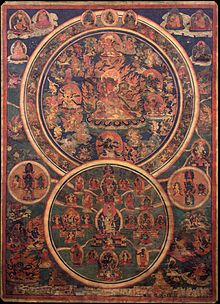
Back Bardo (budisme) Catalan Bardo (buddhismus) Czech Bardo (Yoga) German Bardo budista Spanish Bardo Estonian باردو Persian Bardo (bouddhisme) French Bardo (buddismo) Italian 中陰 Japanese 바르도 (불교) Korean

In some schools of Buddhism, bardo (Classical Tibetan: བར་དོ་ Wylie: bar do) or antarābhava (Sanskrit, Chinese and Japanese: 中有, romanized in Chinese as zhōng yǒu and in Japanese as chū'u)[1] is an intermediate, transitional, or liminal state between death and rebirth. The concept arose soon after Gautama Buddha's death, with a number of earlier Buddhist schools accepting the existence of such an intermediate state, while other schools rejected it. The concept of antarābhava, an intervening state between death and rebirth, was brought into Buddhism from the Vedic-Upanishadic (later Hindu) philosophical tradition.[2][3] Later Buddhism expanded the bardo concept to six or more states of consciousness covering every stage of life and death.[4] In Tibetan Buddhism, bardo is the central theme of the Bardo Thodol (literally Liberation Through Hearing During the Intermediate State), the Tibetan Book of the Dead, a text intended to both guide the recently deceased person through the death bardo to gain a better rebirth and also to help their loved ones with the grieving process.[5]
Used without qualification, "bardo" is the state of existence intermediate between two lives on earth. According to Tibetan tradition, after death and before one's next birth, when one's consciousness is not connected with a physical body, one experiences a variety of phenomena. These usually follow a particular sequence of degeneration from, just after death, the clearest experiences of reality of which one is spiritually capable, and then proceeding to terrifying hallucinations that arise from the impulses of one's previous unskillful actions. For the prepared and appropriately trained individuals, the bardo offers a state of great opportunity for liberation, since transcendental insight may arise with the direct experience of reality; for others, it can become a place of danger as the karmically created hallucinations can impel one into a less than desirable rebirth.[citation needed]
Metaphorically, bardo can be used to describe times when the usual way of life becomes suspended, as, for example, during a period of illness or during a meditation retreat. Such times can prove fruitful for spiritual progress because external constraints diminish. However, they can also present challenges because our less skillful impulses may come to the foreground, just as in the sidpa bardo.[citation needed]
- ^ Bareau, André (1979). "Chuu". In Lévi, Sylvain; Takakusu, Junjiro; Gernet, Jacques; May, Jacques; Durt, Hubert (eds.). Dictionnaire encyclopédique du bouddhisme d'après les sources chinoises et japonaises. Hôbôgirin. Vol. Fasc. 5. Editions Maisonneuve. pp. 558–563. ISBN 9068316052. OCLC 928777936.
- ^ John Bowker, The Concise Oxford Dictionary of World Religions, s.v. [1]
- ^ Bryan Jaré Cuevas, "Predecessors and Prototypes: Towards a Conceptual History of the Buddhist Antarābhava", Numen 43:3:263-302 (September 1996) JSTOR 3270367
- ^ Francesca Fremantle (2001), Luminous Emptiness: Understanding the Tibetan Book of the Dead, p.53-54. Boston: Shambala Publications. ISBN 1-57062-450-X
- ^ Tibetan Buddhism and the resolution of grief: The Bardo-Thodol for the dying and the grieving, by Robert Goss, Death Studies, Vol. 21 Issue 4 Jul/Aug.1997, Pp.377-395
© MMXXIII Rich X Search. We shall prevail. All rights reserved. Rich X Search